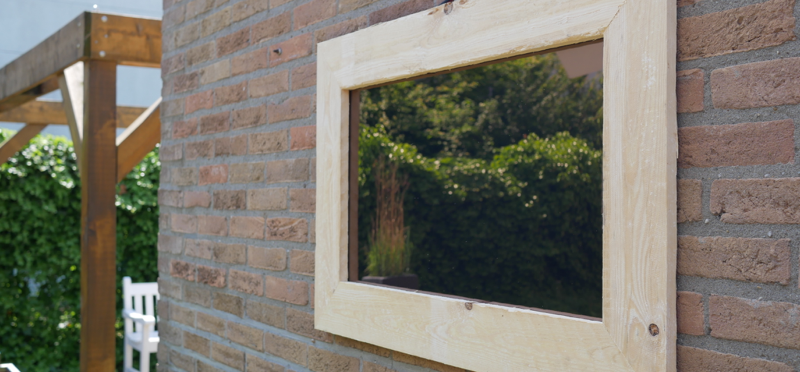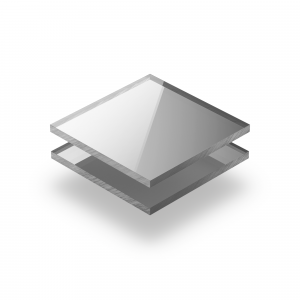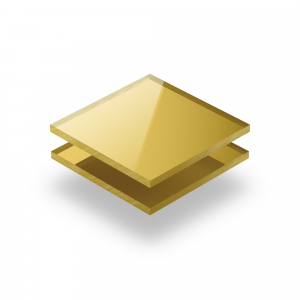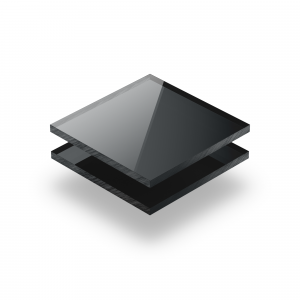Cleaning mirrored acrylic sheets is an essential part of maintaining their appearance and functionality. Over time, dirt, dust and other particles can attach to the surface of the mirrored acrylic sheets. By regularly cleaning the sheets, this material will keep its reflective look.
But be careful, because using incorrect cleaning methods or products can seriously damage this sheet. Acrylic is a relatively soft material, so the use of abrasive and aggressive cleaning agents is out of the question. So do not use scouring sponges, hard brushes, or aggressive cleaning agents like glass cleaner. It is also important to make sure that the film of the acrylic mirror sheet does not become damp, otherwise it may corrode. So do not clean the edges with water. By using the right cleaning method, the acrylic mirror sheet will remain beautiful for longer.
Advantages of acrylic as a mirror over glass
Acrylic mirror sheets have many advantages over glass mirrors.
Below are some examples for you:
Safety: Acrylic mirror sheets are shatterproof, which means they will not break into a thousand sharp pieces in the event of a fall or hard impact. This makes acrylic mirror sheets ideal in environments where safety is paramount, for example in the home with children, or certain public areas.
Lightweight: Acrylic mirror sheets are significantly lighter in weight than glass mirrors of the same size. This makes them easier to process and place.
Durability: Acrylic mirror sheets are less prone to chipping or cracking. And because they are less likely to break than glass mirrors, acrylic mirrors are a more durable choice.
Better processing capabilities: Acrylic mirror sheets are easier to work with than glass mirrors. So for many creative jobs, acrylic mirrors are a better choice.
Budget-friendly: Generally, acrylic mirror sheets are more economical than glass mirrors.
Understanding Acrylic Mirror Sheets
Acrylic mirror sheets are made of acrylic (polymethyl methacrylate). This is a synthetic thermoplastic polymer. The composition and properties of acrylic mirrors can vary, depending on the manufacturing process and the additives used.
However, one thing is certain, mirror sheets made of acrylic are very versatile. Below are some examples of applications where acrylic mirrors are used:
Decoration: Acrylic mirrors are often used in interiors for decorative purposes. For example, you can create a mirrored wall, or accentuate rooms with an acrylic mirror. Mirrored coffee tables, cabinets and shelves are also possibilities.
Shop displays: Acrylic mirrors are often used in shops to create cool displays. This makes products stand out extra well, and improves the overall aesthetics of a shop.
Events industry: As in shops, acrylic mirrors can also make a stand or product more attractive to look at, at an event. The fact that acrylic mirrors are safer than glass mirrors and lighter in weight is also a key point in the event industry, making acrylic mirrors more often chosen instead of glass mirrors.
Art & creation: Mirrored acrylic is used regularly by artists and handymen, for all kinds of creative projects. For example, you can use mirror acrylic to make fantastic mosaics, decorative ornaments, jewellery and other fun DIY projects.
Exhibitions: To display objects more beautifully, acrylic mirrors can be used. Acrylic mirrors can also be used in interactive installations.
Recommended products
Preparing for the Cleaning Process
To clean acrylic mirror sheets, you need a number of supplies. It is good to be aware that acrylic mirror sheets can build up a static charge, which attracts dust. So ideally, choose a soft anti-static cloth and a mild anti-static cleaner.
When cleaning the acrylic mirror sheet, remember not to use too much water. This can actually get stuck behind the mirror film, causing corrosion. It is also wise to take care that no moisture gets behind the sheet, again to prevent corrosion. Keep a dry cloth handy to dry the sheet afterwards.
Basic Cleaning Techniques for Acrylic Mirror Sheets
Once you have your soft anti-static cloth, mild anti-static soapy water and a cloth for drying, you can start cleaning. Below we explain step-by-step how best to go about this.
Step 1: Dusting the surface
Before you start cleaning, it is important to remove any dust or dirt from the surface. This is best done with a dry microfiber cloth or a duster, but always be careful. If you brush coarse dirt particles too hard across the sheet, it can cause scratches. So excessive pressure is not recommended.
Step 2: Wiping down with a damp cloth
After dusting, take a damp microfiber cloth. Make sure it is only slightly damp, and not dripping wet. Then gently wipe the surface with light, circular movements. This is the best way to remove any stains or fingerprints.
Step 3: Using a mild soap solution
For stubborn stains or dirt, use a mild soap solution. Wet a soft microfibre cloth with this solution, again make sure it is only slightly damp and not dripping wet. Then gently wipe the surface in a circular motion, without pressing too hard. Aggressive scrubbing may cause scratches.
Step 4: Drying the surface properly
After cleaning with water and/or mild soapy water, it is very important to dry the sheet properly. This prevents water stains or streaks, and prevents drops from getting behind the sheet, or under the mirror foil. Dab the dry cloth on the sheet, again not using any force. For the best result, make sure no moisture is left on the mirror.
Advanced Cleaning Techniques for Stubborn Stains
Removing stubborn stains from plastic requires extra caution. This is because stubborn stains require aggressive agents, which can damage the surface. It can therefore not be guaranteed that a sheet with a large stain will look like new again after treatment.
Removing glue residues
If the standard cleaning method does not work for removing glue residues, try removing glue residues with a little lamp oil or turpentine, but again only with great caution. It is important to be extremely careful here, as these cleaning agents may also remove reflective properties if they are used all over the sheet. Do not use an abrasive as this may scratch the sheet. Afterwards, rinse the surface with some water, and finally dry it well.
Removing scratches
To remove scratches from acrylic, we recommend using one of our polishes. Choose the appropriate polish, depending on the size of the scratch(s) on the sheet. Use a clean polishing cloth or polishing wheel to apply the polish, and spread enough polish evenly over the damaged area at a low speed. Increase the speed and pressure slightly to polish the area.
Removing paint, ink or marker stains
First, try to remove as much of the excess paint as possible from the plate with a plastic scraper. Then use a cotton swab or soft cloth with a little alcohol or citric acid-based cleaner to gently remove any remaining residue. Afterwards, rinse the surface with some water, and finally dry it well.
Avoiding Common Cleaning Mistakes
To keep your acrylic mirror sheets beautiful for as long as possible, it is important to avoid these common cleaning mistakes:
Scratches on the surface
Do not use abrasive or aggressive agents that may scratch your acrylic mirror sheet. So avoid scouring sponges, abrasives, hard brushes, harsh agents, and glass cleaners.
Do use soft, non-abrasive materials to clean acrylic mirror sheets, such as microfibre cloths, cotton swabs or soft lint-free cloths especially designed for cleaning delicate surfaces.
Using abrasive cleaning agents
Do not use harsh chemicals, solvents or abrasive cleaners on acrylic mirror sheets. These can cause damage, discolouration or even dissolve the mirror coating.
Do use a mild anti-static cleaner especially made for plastics. Always check the label of the cleaning product to make sure it is safe to use on acrylic products.
Do not apply too much pressure
Do not use too much pressure when cleaning your acrylic mirror sheet. Hard pressing or scrubbing, even with a soft cloth, can cause small scratches or even cracks.
Do use light, circular motions with a soft cloth to clean the surface. Let the cleaner do the work and avoid excessive force.
Preventive Measures to Keep Acrylic Mirrors Clean
Prevention is better than cure! To keep acrylic mirrors clean, some preventive measures are useful. Below, we tell you more about two important measures.
Keep a regular maintenance schedule
A regular maintenance schedule is important to ensure that dirt, dust and stains do not have time to adhere to your mirror sheet.
Protect the surface from damage
Take some precautions to protect the surface of acrylic mirrors from possible damage. For example, do not place sharp objects, potentially abrasive materials, or heavy objects that could fall against your acrylic mirror. When working with the sheet, it is wise to use a protective mat to place the acrylic mirror sheet on. Also be careful when installing or moving the sheet.




